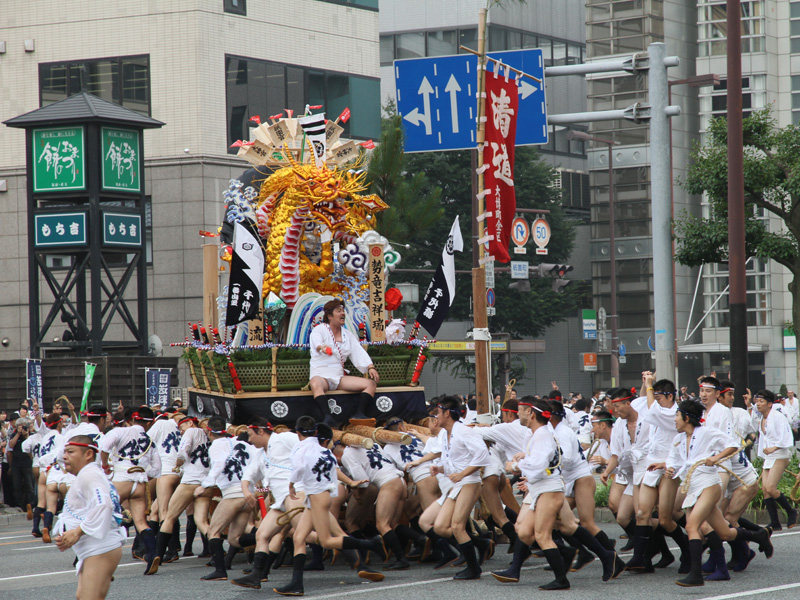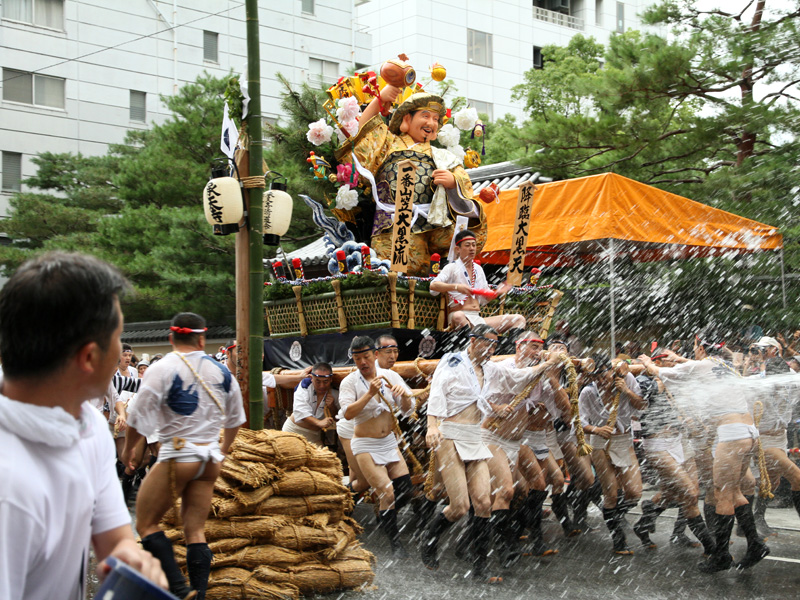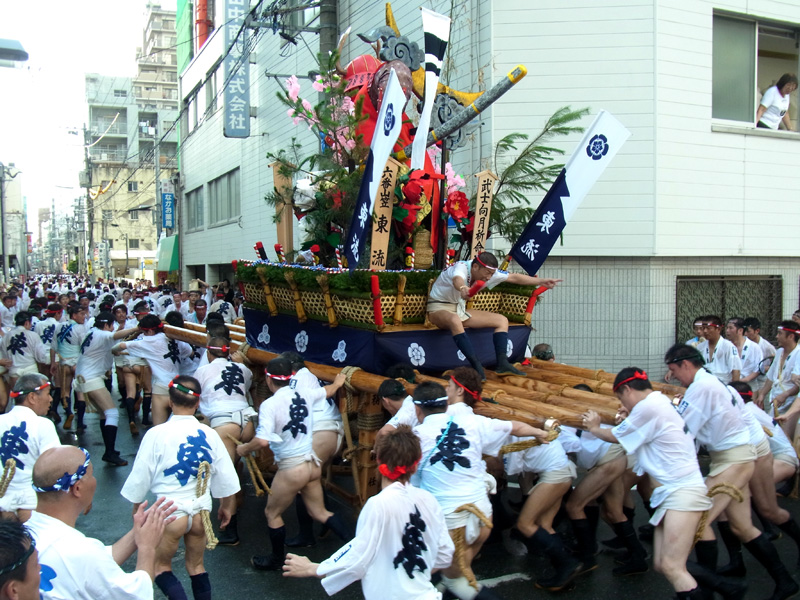The starting point for the presentation of the Kakiyama before the Kushida-shrine where the stress and tension of the carriers before the race can be almost physically felt. Five seconds before the announcement for the next Kakiyama to begin, a huge battle cry from the front can be heard. This moment of silence immediately followed by the battle cry gives a sense for the investment the locals have in the festival.


Viewing Guide
Everything from traveling info over maps to answering your questions
Viewing points

The Kakiyama are run through the city especially on the 12th of July during the Oiyamanarashi, the 13th during the Shudanyamamise and the 15th during the Oiyama. Here a compilation of our favourite viewpoints and some important maps. To see these points marked on the map please click below it.
Route map of the Oiyama and the Oiyamanarashi
This route starts at the Kushida shrine and goes through Hakata for about 5 km before ending at the former house of Hakatas Magistrate during the Edo period, today a sweets shop.
The Oiyamanarashi follows a very similar course, only different in it stopping about one kilometre earlier at Naraya-machi cross.
1. The Yamaretsu (山列)

2. The street before the Kushida-shrine or the the viewer seats (櫛田神社清道・桟敷席)

By the sounds of drums and men shouting “Oisa! Oisa!” the Kakiyama are carried to the Kishida-shrine. The speed at which they are carried is suprising, considering the Kakiyama often weigh more than a ton. By the arrival of the first Kakiyama all the watching people start singing a congratulatory song called Iwaimedeta (祝いめでた). The excitement in the crowd at this point seems graspable. Tickets to the viewer seats are extremely hard to get and sell out 15 minutes after being available. However outside the atmosphere is also awe-inspiring and the ceremony is shown live outside.
3. In front of the Kushida-shrine (櫛田神社 清道正面)

After the presentation of the Kakiyama before the Kushida-shrine, the Kakiyama start racing along the street before the Shrine. Here the real essence of the festival, the racing of the Kakiyama can be followed and the sought after places along the road are often already taken very early in the morning.
4. In front of the Tōchō-ji (東長寺前清道)

Here the Kakiyama, having run through their first stage of Hakata, turn into the second temple road. In front of this, Japans first temple of the Shingon-buddhism sect on this days special flags are set up. When the Kakiyama come in contact with the flags, the sound made can reveal the force behind the carrying of the Kakiyama. There are also a lot of attractions at the Temple, that make it worth visiting when the festival is not under way.
5. In front of the Jōten-ji (承天寺前清道)

The location of the Jōten-ji temple is said to be where the Buddhist Monk Enni Ben’en healed the population of an epidemic in the year 1241 by sprinkling blessed water on them while being carried around on a shelf by townspeople. Thus creating the Hakata-Gion-Yamakasa festival.
Also here the Kakiyama come along a small alleyway that is only 5 metres wide. Then at the Jōten-ji they must do a 180 degree turn, which is very tiring for the carriers, and go back the way they came.
6. Through the district Gokusho (御供所地区)

After the visit to the Jōten-ji, the Kakiyama make their way through the district Gokusho with its many temples. They come along the Shōfuku-ji and the Myoraku-ji and have to somehow manage their way through the crowd that wants to see the temples and the Kakiyama race along side.
However for visitors this is a possibility to see the Kakiyama from up close and see the sheer strength needed to race these large Kakiyama. The vitality water is still thrown upon the carriers so be careful about anything, that shouldn’t get wet.
7. Kamihigashi-machi cross (上東町の四つ角)

After this cross (still in Gokusho) the road goes slightly downhill, making it possible for the Kakiyama to be carried faster. The spectators are able to see the Kakiyama arriving and can enjoy a faster pace run with the Kakiyama. However the road is pretty narrow. So please be careful with the fast Kakiyama, since they are not easily stopped.
8. Kamigofuku-machi cross (下呉服町の四つ角)

A this cross the Kakiyama make a 90 degree turn left while still at considerable speed. Spectators wait on the other side of the cross to watch the speed and force with which the Kakiyama are heaved through the corner.
After this corner only a short alley is between them and Taihaku-street (大博通り).
9. The street Taihaku-dori (大博通り)

Since this road is very large with wide sidewalks, the carriers use this opportunity to change places or swap with others in order to have a short rest. This process however can cause the procession to stride a bit to far to the sides, which makes this spot also a bit dangerous.
A lot of spectators wait here because the sidewalk is pretty wide and they can get close to the Kakiyama.
10. Kyūnishi-machisuji (旧西町筋)

From the large Taihaku-dori the Kakiyama enter another small side alley. Again it is interesting to see the large procession vanish into the small side alley.
A large row of spectators stands along the way taken by the Kakiyama to greet them as they go along.
11. The narrow crossing of the Kyūnichi-machisuji (旧西町筋の狭い四つ角)

This is the most narrow alley along the whole course. While traversing, the Kakiyama sometimes need to be brought into dangerous, slanting positions where you can also see the strength and determination of the carriers.
There are traffic operators, identifiable by their green and white bands, to make sure no one gets in danger and everything goes smoothly. For your own safety we ask to obey these traffic operators.
12. The finish line of the Oiyamanarashi (追い山ならし廻り止め)

While during the Oiyama this point is of no special importance, it is the finishing line of the Oiyamanarashi on the 12th on July, that is carried out in almost the exact same way, except for the earlier finish. This point is about one kilometre before the finish of the Oiyama. It lies at the end of the last long straight stretch of the course, which is why it can also be a good point to watch the Kakiyama accelerate one last time even during the Oiyama. The carriers will fight for every second upon this stretch and can reach an astounding speed.
13. The finish line of the Oiyama (追い山廻り止め)

The climax of the Hakata-Gion-Yamakasa festival. Here the carriers will give their last strength, breath and voice to fight for every second, that they can be faster than the other districts. Here the waiting for the arriving teams, the cheering at every arriver and the stretches of time between arrival and announcement of their time cause a unique atmosphere that truly concludes the 15 days of the festival.
Route map of the Shudanyamamise (13th of July)
1. The starting point

Here the Kakiyama will line up for the procession with the first Kakiyama in front. Since the road here is a lot wider than during the Oiyama and the Oiyamanarashi and the Kakiyama are closer together at the beginning of the procession, it is a lot easier to compare the Kakiyama to each other and view their decoration.
2. Nishi-Ōhashi (西大橋)

After this bridge Hakata ends and Tenjin (Fukuoka) begins. Along both sides of the road the sidewalks are a popular place for viewing the grand procession, also because the bridge is slightly higher than the road, enabling a better view of the way.
3. The processions destination

The destination is in front of Fukuokas town hall, where the Kakiyama will be on display. Here the major, company chefs and other celebrities from Fukuoka will hold a short speech congratulating the first Kakiyama and their district. Since 2010 the Kakiyama take an about 800 metre long detour through Fukuoka on their way back before heading back along the road they came along.
Viewing Guide
Trivia
Even More Information




